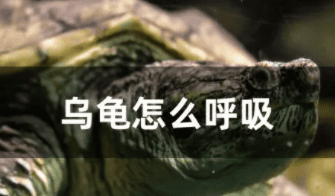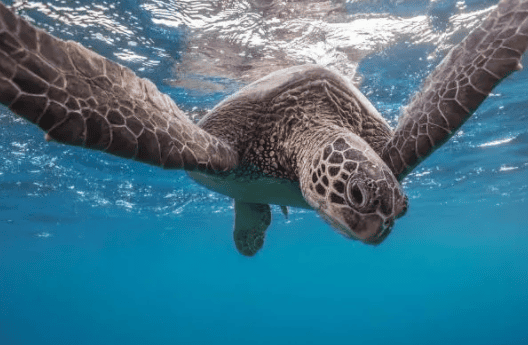Turtles are reptiles that live on land and in water. They have a hard shell, an indented head, limbs and a tail. They are one of the oldest animals on earth and one of the longest-lived animals. Turtles have diverse lifestyles in nature. They can survive and reproduce in different environments and conditions, such as deserts, forests, rivers, lakes, oceans, etc. Turtles also have a strange breathing method in nature. They can breathe with their buttocks. This is a very special breathing method and a very effective breathing method. So, how do turtles breathe through their butts? This article will introduce you to the breathing method of turtles from the following aspects.

Subtitle: Turtle's respiratory organs and functions Turtle's breathing Organs and functions are a fundamental question because they help us understand the nature and characteristics of a turtle's respiration. The respiratory organs and functions of turtles have the following aspects:
- Respiratory organs: The respiratory organs of turtles are very complex. They have different respiratory organs, which can perform different tasks under different situations and conditions. The way they breathe, their respiratory organs include their lungs, nostrils, mouth, throat, trachea, bronchi, alveoli, blood vessels, heart, blood, oxygen, carbon dioxide, etc. These respiratory organs are all the respiratory organs of turtles. A representation of the turtle's breath.
- Respiratory function: The respiratory function of turtles is very important. Their respiratory function is to enable them to carry out effective gas exchange in different environments and conditions, thereby maintaining their life activities. Their respiratory functions can be divided into the following types, such as lung respiration, nasal respiration, mouth respiration, anal respiration, skin respiration, gill respiration, etc. These respiratory functions are all the respiratory functions of turtles and are all manifestations of turtle breathing.

Subtitle: Turtle's anal breathing and its principles
The anal respiration and principles of turtle respiration are a key issue because they help us understand how special and effective turtle respiration is. The turtle's anal breathing and its principles have the following characteristics:
-Anal breathing: The turtle's anal breathing refers to a breathing method in which the turtle breathes with its buttocks. It is a very special breathing method and is also A very effective way of breathing, which mainly occurs in water, especially in winter, when the water temperature is low, there is less oxygen, the turtle's metabolism slows down, and the turtle's lungs are insufficient for breathing, it allows the turtle to carry out effective gases in the water Exchange, thereby maintaining the turtle's life activities, it can also keep the turtle in the water, reducing its own exposure and danger, it can also keep the turtle in the water, saving its own energy and time.
- Principle: The principle of turtle anal respiration is very simple. It uses the structure and function of the turtle's anus and cloaca. Its principle can be divided into the following steps, such as Inhalation, exchange, exhalation, etc., these steps are all the principles and processes of turtle anal respiration. For example, the inhalation step of a turtle's anal breathing means that the turtle uses its anus to inhale water and oxygen in the water into its cloaca. This is because the turtle's anus has a structure called anal valve, which allows the turtle's anus to breathe. The anus can open and close freely, which also allows the turtle's anus to prevent the loss of water and oxygen. This is also because the turtle's cloaca has a structure called a cloacal protrusion, which allows the turtle's cloaca to increase its capacity and surface area. It allows the turtle's cloaca to increase the flow and contact of its own blood and oxygen. - Respiratory function: The respiratory function of turtles is very important. Their respiratory function is to enable them to carry out effective gas exchange in different environments and conditions, thereby maintaining their life activities. Their respiratory function can be divided into The following types of breathing functions, such as lung respiration, nasal respiration, mouth respiration, anal respiration, skin respiration, gill respiration, etc., are all respiratory functions of turtles and are all manifestations of turtle breathing.
- Principle: The principle of turtle anal respiration is very simple. It uses the structure and function of the turtle's anus and cloaca. Its principle can be divided into the following steps, such as Inhalation, exchange, exhalation, etc., these steps are all the principles and processes of turtle anal respiration. For example, the inhalation step of a turtle's anal breathing means that the turtle uses its anus to inhale water and oxygen in the water into its cloaca. This is because the turtle's anus has a structure called anal valve, which allows the turtle's anus to breathe. The anus can open and close freely, which also allows the turtle's anus to prevent the loss of water and oxygen. This is also because the turtle's cloaca has a structure called a cloacal protrusion, which allows the turtle's cloaca to increase its capacity and surface area. It allows the turtle's cloaca to increase the flow and contact of its own blood and oxygen; the exchange step of the turtle's anal respiration refers to the process of gas exchange in the turtle's cloaca. This is because the turtle's cloaca has a type of cloaca called the cloaca. The structure of the mucosa allows the turtle's cloaca to have many capillaries and capillaries. These capillaries and capillaries allow the turtle's cloaca to carry out effective gas exchange, that is, to transfer oxygen in the water to the blood through the cloacal mucosa. in, thus supplying all parts of the turtle's body, and at the same time, the carbon dioxide in the blood is transferred to the cloaca through the cloacal mucosa, and then discharged from the turtle's body; the exhalation step of the turtle's anal respiration refers to the turtle using the anus to remove the carbon dioxide in the cloaca. The process of exhaling water and carbon dioxide into the water is because the turtle's anus has a structure called anal valve, which allows the turtle's anus to open and close freely, and also allows the turtle's anus to control the discharge of water and carbon dioxide. This is also because the turtle's cloaca has a structure called a cloacal protrusion, which allows the turtle's cloaca to reduce its capacity and surface area, and also allows the turtle's cloaca to reduce the flow and contact of its own blood and oxygen.

 扫一扫微信交流
扫一扫微信交流
发布评论